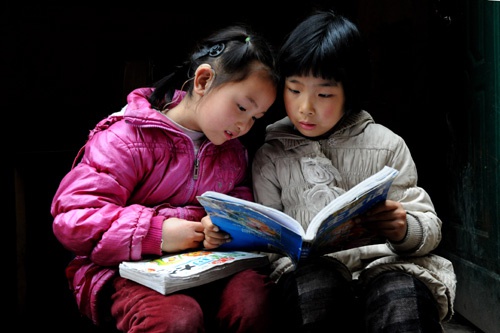|
 |
|
POWER OF READING: Two girls from a migrant worker family read a book together in Zhengzhou of central China's Henan Province on April 22. April 23 is World Reading Day (ZHU XIANG) |
Water Pollution
Nearly 60 percent of areas in China that were surveyed were found to have a "very poor" or "relatively poor" quality of underground water last year, a new report showed on April 22.
Among the 4,778 spots across 203 cities that were investigated by the Ministry of Land and Resources, underground water quality was ranked "relatively poor" in 43.9 percent of them and "very poor" in another 15.7 percent last year, according to the report, which is released by the ministry annually.
According to China's underground water standards, water of relatively poor quality can only be used for drinking after proper treatment. Water of very poor quality cannot be used as a source of drinking water.
The result means 59.6 percent of underground water could not be directly drunk last year, up from 57.4 percent from 2012.
On a year-by-year basis, water quality became worse in 754 monitored spots, but improved in 647 areas.
More Patents
On April 22, China's State Intellectual Property Office (SIPO) said the country accepted a larger proportion of invention patent applications in 2013.
Shen Changyu, head of the SIPO, said China accepted 2.38 million patent applications and authorized 1.31 million of the cases last year. The number of patent applications for inventions reached 825,000, up 26.3 percent year on year.
It is the first time in five years that invention patent applications took up more than one third of the three types of applications, Shen commented at a press conference. The other two types are utility models and design.
China ranked third in international patent applications to the Patent Cooperation Treaty, with more than 20,000 submissions last year.
Less Poverty
The number of impoverished people in rural areas of ethnic minority-inhabited regions decreased by 5.59 million in 2013, China's State Ethnic Affairs Commission (SEAC) said on April 21.
The commission released a statement, saying there were 25.62 million people living in poverty in eight ethnic minority-inhabited provincial-level regions last year.
The regions were Inner Mongolia Autonomous Region, Guangxi Zhuang Autonomous Region, Tibet Autonomous Region, Ningxia Hui Autonomous Region, Xinjiang Uygur Autonomous Region, and the provinces of Guizhou, Yunnan and Qinghai.
About 17.1 percent of people in rural areas of the eight regions live in poverty, 8.6 percentage points higher than the whole country, according to the report.
Poor people in the rural areas of Guangxi, Guizhou and Yunnan account for almost 80 percent of the total in the eight regions, and about a quarter of the total number of poor people in rural areas across the whole country.
| 